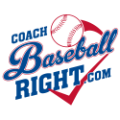Up, up is the way to go. To plane the pitch means to put the swing of the bat in the same plane as the ball, which is moving at a slight angle down from the pitcher’s hand to catcher’s glove. A hitter who swings down on the ball has about 4 or 5 inches of contact area. A hitter who swings level to the ground has about 8 inches of contact area. Hitters who plane the pitch have 14 to 22 inches of contact area.
3 Core Concepts of Rotational Hitting
- Plane the Pitch
- Hips Lead the Hands
- Hands stay Inside the Ball
Plane the Pitch
Hips Lead Hands to Create Torque
Watching the swing in slow motion reveals that the hips pop (not by squishing the bug) from the front side. As the hips pop and begin to rotate toward the pitcher, the upper body moves very little. Separation occurs between the top half and the bottom half of the body.
This separation is called torque and is the source of power in a baseball swing.
Hands Staying Inside the Ball
Keeping the hands inside the ball means that the elbow gets to a spot near the ribs as the hitter gets into the approach or short 3 position.
At this point, as the hands begin to move they move in a circular path rotating with the upper body.
Many youth hitters throw their hands out to the ball, but this causes their hands to work against the upper body and not with it. When done correctly, the hitter who keeps his hands inside the ball will be able to keep more balls fair, and he will have a short compact swing. Compact swings are the most powerful type of swing, and they allow hitters to wait for the ball a split second longer than players that have long and slow swings. In the image below the hitter’s hands move in a circular fashion even though the pitch is on the outside part of the plate! The hands follow the upper body as the upper body rotates around its axis!







